
Alternative Space Loop, an institution which has been committed to introducing emerging artists from Asia and providing a platform for communications between them, is to present artist You Jin’s solo exhibition “The View of Heterotopos”, not only for its aim to introduce the practice of young Chinese artists, but also for an interest in the interpretation of eastern and Asian values as revealed in You Jin’s works, and the recognition that the artist has the future potential to transcend the East-West dichotomy. You is more than an artist creating an experimental painting trend in contemporary China, his works are based on multifaceted experiments with western painting techniques and a deep focus on traditional Chinese culture and art, through which he develops artistic practice illuminating directly, or indirectly the rapidly changes in Chinese society. You is also an artist who expands the possibilities of contemporary painting by surpassing the boundaries of various domains including digital media and fashion and design. In this exhibition, the artist will present his most recent representative creations, with a special display of digital media works revealing a different aspect of his art.
In Foucault’s argument of “Heterotopias”, he proposed an “alternative space” other than the spatial concept in classical philosophy and physic; unlike “Utopia”, heterotopias are a physically existing space that requires the help of imagination in order to be comprehended. It juxtaposes spaces and time that cannot coexist and forms a “real” site. Through You Jin’s distinct characteristics in painting, he combines different temporal and spatial dimensions on a single composition, with the attempt to bring forward implications of and alternative perspectives on the strange and complex specialties and temporary nature in our times. The genuinely perceptable “Heterotopos” shows a passage through which You’s artistic realm can be examined, and operates on the viewers in a multifaceted way at the same time.
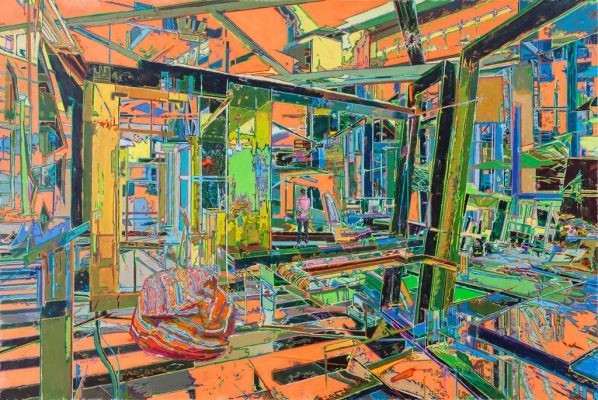
You Jin, Exceptional Situations Beyond Control, 2014; Oil on canvas, 300x200cm
As the axes of You’s artistic practice, temporary and space are derived from a powerful focus on and intervention in modern life. The density and strength of his compositions were increased by beginning from everyday scenery feelings or objects, and the gradual expansion of the spatial qualities of his paintings while involving temporal qualities through an alternative linear method. Multi-dimensional and illusive composition is rich and has diverse lines, intense and brilliant colors, and the private spirituality in his works underly the iconic features in You’s paintings. These features are not static, quite on the contrary, they proliferate rapidly and flexibly along the axes in recent years. This proliferation is particularly reflected in his works since 2014, from which we can clearly observe a further evolution of temporary art and space.

You Jin, Forgotten Vacancy, 2015; Oil on canvas, 280x180cm
“The View of Heterotopos” is You Jin’s first solo exhibition in Korea, in which all paintings are selected from You’s recent works since 2015. The complex vision of intertwining time and space in his compositions, in fact, this encompasses the East and West, tradition and modernity, an Asian landscape divergent from Western-centric modernization, and a result of a dramatically changing era; thus, it has to inform humanity and society with a broader viewpoint. The tigers, pandas and Mickey Mouse appear simultaneously in his work The Ninth Buddy and Two Tigers, and the symbolic applications of Chinese gardens and furniture shown massively in Forgotten Vacancy, Overwhelmed Landscape, Search Best Structure, and In the Dream were actually the nostalgia for Chinese traditions and space in the process of becoming international; countless Chinese doors and windows in What is Persistent and Hidden allude to passages and the media to enter into or exit from the world; and the languidly relaxing figures in Helpless dormancy and Overwhelmed Landscape emerge in the compositions like tramps. You Jin uses these space-time scenes of repetition, movement, stagnation, openness and closure as metaphors for the repeated deconstruction and construction in China’s dynamic social changes.
Although You Jin’s Painting contains unpredictable changes of time and space, it is always heading toward a certain and stable order that seeks to view a chaotic and disordered world with a serene mind. Combining his paintings with Eastern thought in a self-disciplinary way, rather than simply repeating deconstruction and construction in the real world, You Jin seeks to find a more liberal way to free himself from the wrinkling and unfolding of reality’s space and time.
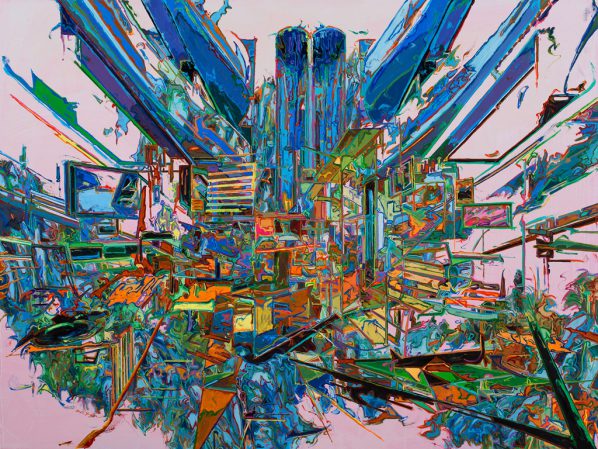
You Jin, Fragmented Soul in a Trapped World, 2015; Oil on canvas, 200x150cm
Over the past decade, You Jin’s oil painting has maintained a steady internal line of inquiry, displaying a powerful focus on and intervention of modern life in the content of his works, with the construction of surreal visual spaces through the formal language of dynamically colored lines. There has, however, been a major change in his recent works from those created before 2008, a change mainly manifested in his exploration of painted space. This space is neither the three-dimensional illusory space of traditional realism, nor the symbolic space of Chinese traditional ink painting. Instead, it is a disjointed and moving reconstructed space. The two former types of space are static and marked by agreement between subjective observation and expression of the imagination, while the space in You Jin’s works is an undefinable drifting space of disjointed intersections. The viewer’s gaze cannot find a defined point of observation within, and thus cannot find a basis for spatial recognition from which to unfold the experience of the space.
In other words, the space in You Jin’s works is not the traditional space of knowledge production. We are unable to find historical coordinates within, or establish the artist’s value judgments that are based on them. What he presents is a scrambling and contradiction of space. This scrambled space is a reflection of the contradictions of our present society. I believe that this is not a physical space but a psychological space. Space does not only produce and store materials. It can also produce sentiments, just as the narrow space of the subway makes people tense and anxious, while a visit to nature can produce an open mind and light spirit. This is mainly determined by how open or closed the space is. The space of the modern metropolis often produces feelings of inhibition, confusion, ennui, desire and illusion, products of the competiveness fostered by the rarity of space and high levels of productivity.
American scholar Daniel Bell held that a striking trait of urban life is its emphasis on the visual. The reasons for this are that, “First, the modern world is an urban world. Life in the great city and the way stimuli and sociability are defined provide a preponderance of occasions for people to see and want to see (rather than read and hear) things. Second is the nature of the contemporary temper, with its hunger for action (as against contemplation), its search for novelty, and its lust for sensation. And it is the visual element in the arts which best appeases these compulsions.”[*] The city is more than just a spectacle, an economic space, a population cluster, a center for life, labor, political culture and information. It is more of a state of mind, “A symbol of a distinctive style of life whose major attributes are variety and excitement.” In this way, the production space and consumption space of the city are often interchanged, forming the foundation for the production of psychological space. There is an old Chinese saying about being in one place but longing for another, which touches on spatial dislocation between mind and body. Psychological space is an independent space within the individual. It is influenced by external space, sometimes in line with external space, sometimes in opposition to it. For instance, difficult environments often spur staunch determination. This decoupled psychological space can be understood as an alternate space.
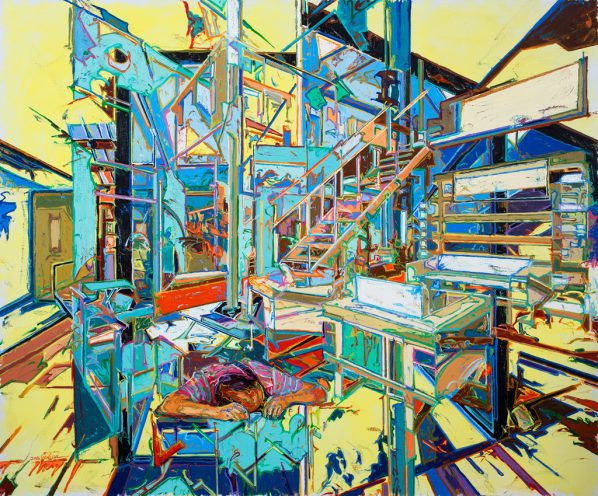
You Jin, Helpless dormancy, 2016; Oil on canvas, 180 x 150cm
As a space for production and consumption, the modern city is the quintessential expression of modern man’s ways of survival, culture and social interaction. Since mankind departed from the primal state, there have been certain visible physical changes, but the greatest changes have been in mindset, particularly with the rapid expansion of modern capitalism and urban development since the great age of discovery from the 15th to 17th centuries, which led to the most drastic changes in modern man and the environment. These changes greatly expanded mankind’s space while profoundly altering mankind’s mental state. Today, the spatial expansion continues, with even Antarctica and space being eyed as spaces for future existence. I believe, however, that the most important expansion space today is the internet space, which has already brought extreme changes to contemporary ways of life and mental states.
As French physicist and mathematician Blaise Pascal (1623-1662) wisely observed, “Nature is an infinite sphere of which the center is everywhere and the circumference nowhere.” Today, we are all on the move. Some people migrate to new cities for a better life, while many more rush about in various vehicles for work. There are also many people who do not move their bodies, but can switch between various satellite channels with their remote control and wander the world throughthe Discovery Channel and travel programs. They can also instantly find information from anywhere in the world through computers and the internet, realizing that the line from the poetry of Mao Zedong: “Travelling thousands of miles in a day while sitting stationary.”
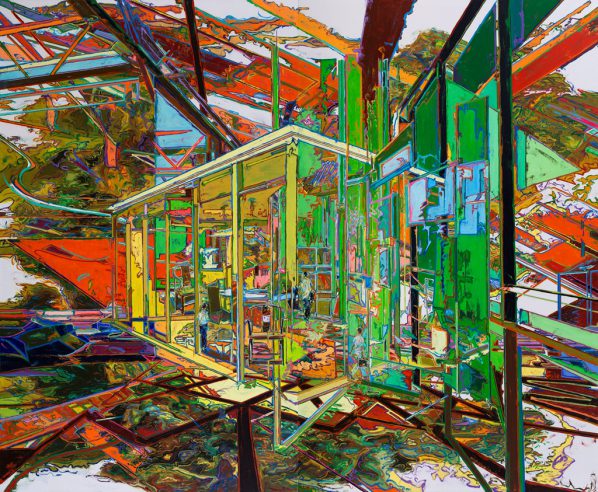
You Jin, The Nearest Distance, 2015; Oil on canvas, 260x158cmX2pcs
Thus, spiritually speaking, we are all travelers. That is to say, in the city, we are urban vagrants who maintain constant contact through communication tools. The figures in You Jin’s works lack status or profession. Generally, they can be classified as travelers and vagrants of the modern city. The pace of change in the world is accelerating, and the change is causing the concept of stillness to disappear. The future of life and development has become dense and chaotic, impossible to predict or grasp. Globalization is pulling economies and cultures towards the fleeting, the changing and the unstable.
In such an era, all products, services and signifiers must strive to stand out, to draw in the people’s attention. This is the era of the “attention economy.” The endless expansion of college advertising and design programs reflect the prime importance of luring eyeballs in this era. Behind the eyeball economy is the infinite consumer desire fostered by competition and advertising. In past eras, the ordinary dreams of common people may have taken a lifetime to realize. Today, many people can realize their dreams in a single night. Once time can be compressed to realize instant gratification, all that people can hold onto is the desire for new desires. Even the wealthiest people in the world are dogged by desires, and complain about the ones left unfulfilled.
In comparison to past generations, we have truly entered into a “consumer society.” Our predecessors consumed as well, but theirs was a “production society.” One of the key problems they pondered was whether “man worked to live or lived to work.” Today, the question that confounds us is whether we “consume to live or live to consume.” A major trait of consumer society is that consumption is not satisfied. For the consumer, no object of consumption is worth holding onto for long. Nothing has a lasting meaning. The consumer cannot fix their attention and desire onto a single object. Their emotions are constantly tiring of one object and shifting passionately to the next new thing, leaving them anxious and restless. In a sense, what the consumer consumes is not a material object, but the desire constantly stoked by the producers and conveyers.
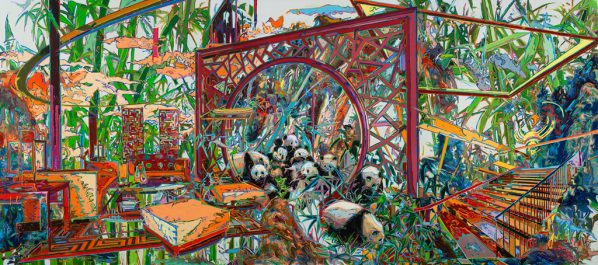
You Jin, The Ninth “Buddy”, 2016; Oil on canvas, 200 x 150cmx3pcs
As a result, a fundamental dilemma facing our consumer society is that none of us are able to choose this society. Whether we like it or not, we all live within this consumer society. We are all on the journey. No one asks us what we are feeling, and no one cares where we are going. You Jin became aware of the shifts in human spatial awareness and complexity in human mindsets brought about by this consumer society. In brilliant colors, he conveys the material excess of modern consumer society. His art conveys the beautiful surface of our era, as well as the danger lurking beneath. He infuses grave concern into dazzlingly colorful scenes, revealing the impermanence of history amidst the carnival. Many beautiful, timeless and natural things coexist with the violence and war of human society. Painstaking creation goes hand in hand with instantaneous destruction. When I saw You Jin’s meaningful and conscientious painting amidst the universal consumerist impulses of his generation of young artists, I was touched and astonished.
You Jin’s works since 2012 maintain the illusory images constructed from colorful lines. How should we go about understanding this strong linear expression in You Jin’s painting? The colored lines and temperature contrasts form a rich vision of color, but this vision is just so unreal. Works such as Clouded Metropolis evoke the imagery of fabled lands from ancient Chinese mythology, and call to mind the great geographic text Classic of Mountains and Seas. This is an imaginary world, a transcendence of the real world.
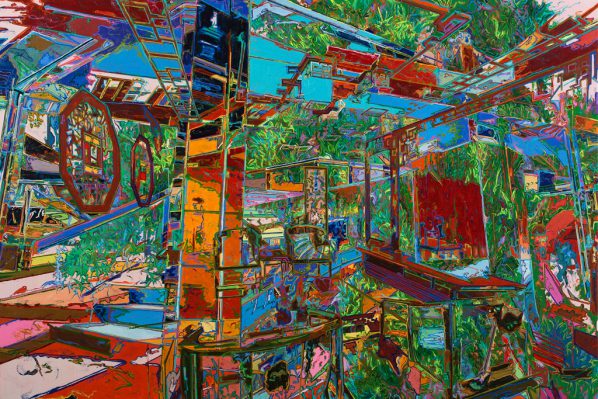
You Jin, What Is Persistent and hidden, 2015; Oil on canvas, 300x200cm
Many of You Jin’s recent works convey the imagery of “people and boats.” Like Ang Lee’s 2012 film The Life of Pi, they appear to be about the struggle between man and nature, but allude to the struggle between man and his surroundings. You Jin’s Unattached Boat (2012) and In the Same Boat depict single figures in solitary boats. Many of his works contain this imagery of a person drifting in empty space in a boat. The works Free Think (2013) and Life is Like a Drama (2014) depict people and boats in an indoor space and in front of a stage, respectively, extracting the people and boats from reality and transforming them into symbols of fate. Meanwhile, as the backdrop to people and boats, the sea shows the vastness of the world people confront. This sea imagery reflects the smallness of the individual, while also highlighting the individual’s spiritual strength to grasp onto their destiny. Unlike Ernest Hemingway’s The Old Man and the Sea, You Jin’s Giant (2012) depicts the figure of a person. He is facing the sea, but his body is drifting apart in the air.
You Jin’s works also depict people and fish as a symbolic expression of the relationship between the individual and the group. Chaos Freedom (2012) reflects human solitude, while Realistic Shadows (2012) and This is Your Problem (2012) convey the fall from the heights of consumption. Don’t Cry, Dear (2012) depicts a boy and a girl consoling each other atop a massive pile of refuse from the consumer era. We don’t know where that indescribable sorrow stems from, but it does reflect the younger generation’s anxiety about the world and confusion about the future.
Images of books and libraries emerge in You Jin’s works from 2013. A spinning staircase occupies a narrow indoor space. Where will it lead us? Is it mankind’s destiny towards an upwards spiral? At a time when the internet dominates, and thereading of books is on the decline, what does the artist’s frequent depiction of books imply? Imagery of the stage is also more common in this period. In When I Encounter You (2014), the stage and the space outside the window are connected. The viewer joins the bicycle-riding youth in looking into the depths of the stage, just as the viewer joins the wheelchair-bound person in The Next Lecture in gazing down a resplendent hall, the space filled with a lingering sense of loneliness. The repeated appearance of the stage and curtains demonstrates the painter’s understanding of life. In this dramatized perspective, we gain a sense of the traditional Chinese notion of “life is like theater, and theater like life,” bringing us a surreal absurdity and sense of illusion within an already overstimulating modern metropolis.
Expressions of space have also repeatedly appeared in You Jin’s works since 2014, gradually becoming the center of the expression. These artworks are not a representation of real space but are instead the artist’s reflections on space, resulting in the expression of the psychological nature of space. You Jin’s works often depict the intersection and overlap between indoor and outdoor space. This is not the Cubist logic of 20th century modern painting but the layered design of computer vision. “Exit” Hello! (2014) depicts an indecipherable labyrinth where glass mirror reflections and revolving doors create a series of nested passages through a space which cannot be linked together. The disorienting spiraling space Drifting Arduously (2014) mirrors the oil painting suspended in space in Tradition between Reality and Fantasy (2014), but it also contains Chinese-style doors and windows. In I Can’t See You in Here (2014), the person becomes a fragmented presence gradually melting and disappearing into the dazzling space.
I have noticed that You Jin’s recent works have incorporated many signs from Chinese landscape art. In the Ming and Qing dynasties, many outstanding Chinese painters, such as Shi Tao, took part in the design and creation of landscape gardens in the Jiangnan region. Their employment of the spatial principles of Chinese painting within these limited spaces turned the landscaped garden into the spiritual homeland of the Chinese literati, and made them fashionable among the social elite. In his works since 2015, You Jin has been using elements of Chinese gardens and indoor furniture as signs, in an elegy to traditional culture and traditional space. Forgotten Vacancy, Overwhelmed Landscape, An Old Place Unworthy of Nostalgia and other works created in 2015, reflect these sentimental feelings towards traditional cultural space. In these works, modern architecture and traditional gardens intersect, and plants and animals from the natural world conflict with the modern urban environment. There is even a scene of two tigers facing off in a beautiful Chinese garden. Such works as Path and Whisper convey the smallness of the individual, the lack of space for love in the industrial era, and the unmoored spirits of the complex urban architectural space. From the appearance of the panda in Top Amusement Park to the group of pandas and Mickey Mouse in The Ninth Buddy, we see an heightening of the viewer’s sense of hopelessness in reality.
On this matter, You Jin says, “I have enhanced the depiction of space in my works. The entire painting is an abstract arrangement of perspectives and reflections that presents an illusory, alluring and dramatic scene.” Spatial arrangements are the theme of You Jin’s recent artistic explorations, but these spatial arrangements are full of challenges to our understanding of life and our psychological reconstructions. As You Jin sees it, mixed and chaotic spatial arrangements are a new medium between people and society, a form of linkage between people and the outer world. In modern society, the experience of the environment plays an important role. In this sense, You Jin is not so much a producer of visual images as an arranger of visual society, using arrangements of time and space, color fields and colored lines to create virtual images that contain new visual experiences. Through his practice, time and space gain the potential to catalyze with each other, giving You Jin’s creations limitless potential. In his future works, he will continue to explore the use of existing materials and figures to arrange time and space, seeking out new breakthroughs in the conveyance of the social environmental states and emotions through constant creative experimentation and progress.
I would like to close with my commentary on You Jin’s works in 2008: “You Jin uses illusory image constructs to abstractly convey the inner truth of the world, using brilliant colors to express a certain emptiness to real life, using digital image manipulation methods to resolve the paucity of the literati spirit in modern man, and using flat painting to express his concern for the depth of history. His hope is that this society can be more harmonious and beautiful, and that the younger generation can find true unity between the spiritual and material life, between surface and substance.” His cultural sentiments and spatial thinking will continue in his future creations, and will one day become one of the most valuable artistic forms in Chinese contemporary art.
June 10, 2016, Beijing
Yin Shuangxi
Professor, Central Academy of Fine Arts
Art Critic
Editor-in-Chief, Fine Arts Research
[*] Daniel Bell, The Cultural Contradictions of Capitalism, Beijing: Sanlian Bookstore, first edition, May 1989, p. 154.
About the artist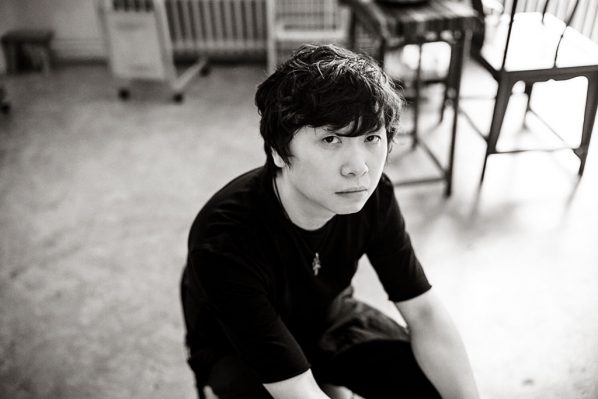
You Jin was born in Shenyang, Liaoning province in 1979. He graduated from Luxun Academy of Fine Arts in China, and now lives and works in Beijing. His major solo exhibitions includes “Chaotic Code” (New Age Gallery, Beijing, 2008) ,“Continue Chaotic”(EGG Gallery, Beijing, 2009), “Lost in Desire”(Opera Gallery, Geneva, Switzerland,2011), and “From Chaos to Freedom”(Opera Gallery , Geneva, Switzerland, 2013). You Jin is an active artist in the international art scene, who has participated in group exhibitions held by art institutions in Shanghai, Moscow, Taiwan, Berlin, Florida, Miami, London, Singapore, Jakarta, Seoul, Hong Kong, etc.
About the curatorMin Byung Jic, born in 1970, graduated from Korea University with a major in Philosophy. He also received a master’s degree in Aesthetics from Hongik University with a thesis on “Michel Foucault’s Visuality.” He has worked as an assistant curator at ArtSonje Center, a curator at Ilmin Museum of Art and a chief curator at Daelim Museum of Art. He was a chief curator for the 1st Seoul International Photography Festival and worked at the City Gallery Project in Seoul. Also, he worked as a chief curator at Pohang Steel Museum of Art and an exhibition director at the culture station Seoul 284(former Seoul station). Now, he has served as a vice director at an alternative space LOOP. His interests lay in visual culture, visual theory, contemporary art, photography, design, public art, cultural policy and humanities. He often takes part in critical writing on visual culture.
About the exhibition
Curator: Min Byung-Jic
Opening Ceremony: 2016.09.02 19:00
Duration: 2016.09.02-2016.10.02
Venue: Alternative Space LOOP (335-11 Seokyo dong, Mapo gu, Seoul, Korea)
Courtesy of the artist and Alternative Space LOOP.




























